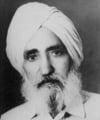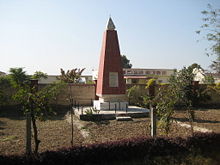Achhar Singh Chhina
| Achhar Singh Chhina | |
 Achhar Singh Chhina
| |
| Born | October 01 1899 Amritsar, Punjab, India |
|---|---|
| Died | March 21 1981 (aged 81) Amritsar, Punjab, India |
| Occupation | Politician |
Achhar Singh Chhina (1899-1981), was an Indian communist politician and activist for independence from British rule. He served as a Communist Party of India MLA in the Punjab Legislative Assembly for two terms. In 1962, he ran for the position of Member Parliament (MP) from Taran Taran, losing by 1600 votes.
Early life
Born at village Harsha Chhina, Tehsil Ajnala, Amritsar, Punjab, India, in 1899, Achhar Singh Chhina completed studies at Khalsa College, Amritsar. He played an active role in college politics along with Pratap Singh Kairon, later the Chief Minister of Punjab. In 1920-1921, the students and teachers of the Khalsa College registered their protest against the British rule by boycotting the visit of the Prince of Wales to the college.
In 1921, Chhina and Pratap Singh Kairon went to the USA for further studies. Both entered Berkeley University, California Masters in Economics program. The same year he joined the Ghadar Party in San Francisco, an organization of Indians in the USA and Canada dedicated to wining independence from the British Raj. He gained valuable experience with participating in political organizations in the Ghadar Party.
Political career
In 1932, Chhina departed the USA and went to the USSR for studies in communism. He returned to India in 1936, the British arresting him in Lahore the same year, detaining him in Lahore Fort for two months.
Fatehwal Murder Case 1938-39
In 1937, British Government refused Achhar Singh Chhina permission to travel outside his home village for one year. In March 1938, on completion of his village confinment period, the communist party organized a conference at Fatehwal village Amritsar, designating Chhina and Mohan Singh Batth as chairpersons. During the conference, attendees murdered two people whom they suspected of spying for police. Police arrested Chhina and Joginder Singh Chhina, along with other forty seven persons, under section 302 IPC,[1] charging them with murder.
The case attracted national attention, the communist party establishing a legal team to defend those arrested. Pandit Jawahar Lal Nehru and Saifud-din Kichlu headed the team, Kichlu representing the defendants as their chief advocate. Police had coerced Ram Lal, a police constable, to give a false statement at the time of murder, fingering Achhar Singh Chhina as the main person to attack and kill the victims. Lal refused to give that statement in the court.[2] The judges found Achhar Singh Chhina not guilty on all counts while sentencing Joginder Singh Chhina to twenty years. Chhina went underground as a result of police efforts to seeks ways to rearrest him following the Fathehwall Murder Case. [3]
Subash Chandra Bose (Netaji)
Subash Chandra Bose, known by the popular name "Netaji" or "Respected Leader," first met Achhar Singh Chhina in April 1939 when Netaji visited the Gaya district while Chhina hide from the police. Netaji advised, Chhina to remain underground, as police where anxious to arrest him on false charges.
Niranjan Singh Talib
Netaji took an interest in Chhina, viewing him as a leader for the budding communist movement and for the independence movement in India. Netaji initiated a series of moves meant to raise Chhina into a prominent leading role. In one of his first moves, Netaji arranged a meeting between Niranjan Singh Talib, a well-known freedom fighter, and Chhina in early June 1940. Next, during Chhina's visit to Calcutta, Netaji encouraged Chhina to travel to the Soviet Union with him to meet Stalin.[4]. Chhina accepted to offer, traveling to the Frontier Province to make arrangements for their illegal trip to Russia.
Trip to the Soviet Union
While in the Frontier Province Chhina met Bhagat Ram Talwar who made arrangements for Netaji and his lodging in Peshawar as well as the logistics necessary for their underground trip to Kabul[5]. The plans thwarted when police arrested Netaji on charges stemming from the Black Hole of Calcutta Movement in 1940 before he could travel to Peshawar.[6]. Chhina decided to make the trip alone in 1940, crossing the Hindukush Mountains on foot through Kabul to the Soviet Union to discuss Indian independence with top leaders of the USSR.[7].
Achhar Singh Chhina and International Politics
In 1942. The CPI was officially against the Quit India movement. Achhar Singh Chhina [known as ‘Larkin’ in Soviet Union] was actively involved in international politics. He worked closely with CPI to develop a directive of CPI, and carried that directive from the Soviet Union to India with the full knowledge of the British authorities.[8]
While crossing the Hindukush he was arrested by British government at Gilgit and was brought back to Lahore where he was locked up in Lahore Fort Cell. After staying for 4 months in Lahore Fort, he was transferred to the Campbell pore Jail from where he was released on 1st May 1942.
President of the Punjab Kisan Sabha
In 1942 he was elected as President of the All India Kisan Sabha - Punjab and held this position for seven years. It was in that capacity that he organized the Harsha Chhina Moga Morcha in 1946, as a result of which he was detained in Lahore jail for three months [9]. He also held a post of Secretary of the Punjab Communist Party.
Harsha Chhina Mogha Morcha 1946-47
In 1946, under the leadership of the Communist party 'Mogha Morcha of Harsha Chhina' was launched. Comrade Acchar Singh Chhina, Sohan Singh Josh, Purran Singh, Mohan Singh Batth, Jagbir singh Chhina, and Gurdial Singh Dhillon organised this Morcha against the ruling party, as a result of which Comrade Achhar Singh Chhina, Sohan Singh Josh and Gurdial Singh Dhillon was arrested along with 950 protestors and detained in Lahore jail for three months. [10] [11]
Due to this movement, all political parties negotiated with the ruling government to give farming water to the agriculturalists as per the agreement. [12] [13]
After Independence
In 1948 after India independence he went underground but was arrested in 1950 and detained in Ambala jail. While he was in jail, he was elected from Ajnala as a member of the Punjab Legislative Assembly (MLA) in 1952. In 1957 he was again elected from Ajnala as a member of the Punjab Legislative Assembly (MLA) and remained its member till 1962[14]. He was a founder of ‘Naveen Janta Public school’ which was taken over by the Punjab Government later and the name of the school was changed to “Comrade Achhar Singh Chhina Senior Secondary School.”
Positions held
1. President of the Kisan Sabha Punjab
2. Secretary of the Punjab Communist Party
3. Member Punjab Legislative Assembly - Ajnala (1952-1956)
4. Member of the Legislative assembly - Ajnala (1956-1962)
5. Member of the Ghadar Party Martyrs Memorial (Desh Bhagat Yaadgar), Punjab
6. Member Gadhar Party San Francisco (1922)
7. Founder of Naveen Vidhya Mandir, School
See also
- Partition of India
- Fundamental Rights, Directive Principles and Fundamental Duties of India
- Caste system in India
- Flag of India
- Political integration of India
- Fundamental Rights in India
- Communism
- Quit India Movement
- Communist Party of India
Notes
- ↑ Indian Penal Code. Whoever commits murder shall be punished with death, or imprisonment for life and shall also be liable to fine.
- ↑ Fauja Singh, Chaman Lal Datta, Bakhshish Singh, Punjabi University Dept. of Punjab Historical Studies - Who's who: Punjab Freedom Fighters - Biography & Autobiography (1991), p. 342.
- ↑ Mihir Bose, Raj, Secrets, Revolution: A Life of Subhas Chandra Bose (India) (2004), p. 175.
- ↑ Fauja Singh, Eminent Freedom Fighters of Punjab(Punjab: India, 1972), p. 59.
- ↑ Bhagat Ram Talwar, The Talwars of Pathan Land and Subhas Chandra's Great Escape (India) (1976), p. 184.
- ↑ Sisir Kumar, Netaji and India's Freedom: Proceedings of the International Netaji Seminar (India) (1975), p. 153.
- ↑ Fauja Singh, Eminent Freedom Fighters of Punjab (Punjab: India, 1972), p. 60.
- ↑ Fauja Singh and Chaman Lal Datta, Who's who: Punjab Freedom Fighters (Punjab: India, 1991), p. 5.
- ↑ Mridula, Peasants in India's Non-Violent Revolution: Practice and Theory (2004), p. 227.
- ↑ S. Gajrani, Peasant Movement in Punjab, p. 33
- ↑ S. Gajrani, Peasant uprisings (1987), p. 120.
- ↑ Peasants in India's Non-violent Revolution: Practice and Theory, p. 567.
- ↑ Mridula Mukherjee, History (2004), p. 577.
- ↑ Hari Singh, Agrarian Scene in British Punjab(Punjab: India, 1984), p. 332.
ReferencesISBN links support NWE through referral fees
- Bose, Mihir. 1982. The lost hero: a biography of Subhas Bose. London: Quartet Books. ISBN 9780704323018.
- Bose, Mihir. 2004. Raj, secrets, revolution: a life of Subhas Chandra Bose. Norwich: Grice Chapman. ISBN 9780954572648.
- Chandra, Bipan. 1983. The Indian left: critical appraisals. New Delhi: Vikas. ISBN 9780706921038.
- Fauja Singh, C. L. Datta, and Bakhshish Singh. 1972. Who's who: Punjab freedom fighters. Patiala: Dept. of Punjab Historical Studies, Punjabi University. OCLC 724163.
- Gajrani, S. 1987. Peasant movement in Punjab. Delhi: Anmol Publications. OCLC 16706374.
- Grover, Verinder. 1989. Political system in India. New Delhi: Deep & Deep Publications. ISBN 9788171001262.
- Hari Singh. 1983. Agrarian scene in British Punjab. New Delhi: People's Pub. House. OCLC 10823960.
- International Netaji Seminar, and Sisir Kumar Bose. 1975. Netaji and India's freedom: proceedings of the International Netaji Seminar, 1973. Calcutta: Netaji Research Bureau. OCLC 2542159.
- Josh, Bhagwan. 1974. Communist movement in Punjab: (1926-47). Lahore: Book Traders. OCLC 85190394.
- Josh, Sohan Singh. 1977. Hindustan Gadar Party: a short history. New Delhi: People's Pub. House. OCLC 5287232.
- Josh, Sohan Singh. 1991. My tryst with secularism: an autobiography. New Delhi: Patriot Publishers. ISBN 9788170501275.
- Mangat, Gurbachan Singh. 1986. The tiger strikes: an unwritten chapter of Netaji's life history. Ludhiana: Gagan Publishers. OCLC 14378940.
- Markandeya, Subodh. 1990. Subhas Chandra Bose: Netaji's passage to im[m]ortality. Bangalore: Arnold Publishers. ISBN 9788170312413.
- Mukherjee, Mridula. 2004. Peasants in India's non-violent revolution: practice and theory. Sage series in modern Indian history, 5. New Delhi: Sage Publications. ISBN 9780761996866.
- Sen Gupta, S. C. 1982. India wrests freedom. Calcutta: Sahitya Samsad. OCLC 9244520.
External Links
Links retrieved November 23, 2008.
| |||||||||||||||||||||||||
Credits
New World Encyclopedia writers and editors rewrote and completed the Wikipedia article in accordance with New World Encyclopedia standards. This article abides by terms of the Creative Commons CC-by-sa 3.0 License (CC-by-sa), which may be used and disseminated with proper attribution. Credit is due under the terms of this license that can reference both the New World Encyclopedia contributors and the selfless volunteer contributors of the Wikimedia Foundation. To cite this article click here for a list of acceptable citing formats.The history of earlier contributions by wikipedians is accessible to researchers here:
The history of this article since it was imported to New World Encyclopedia:
Note: Some restrictions may apply to use of individual images which are separately licensed.




